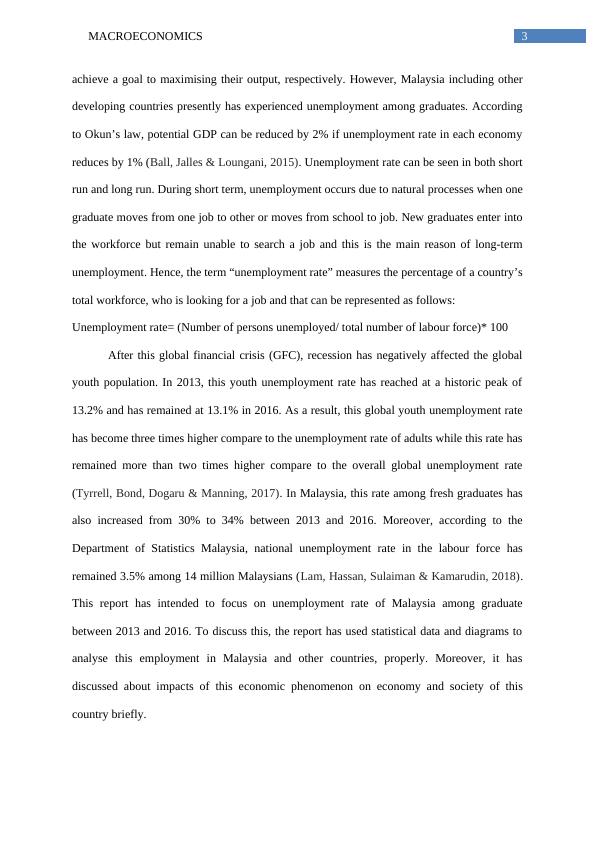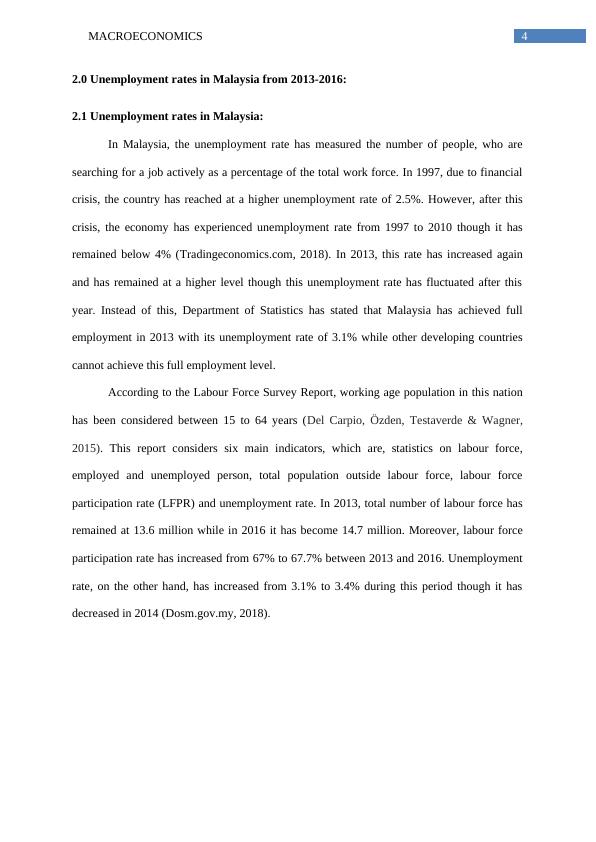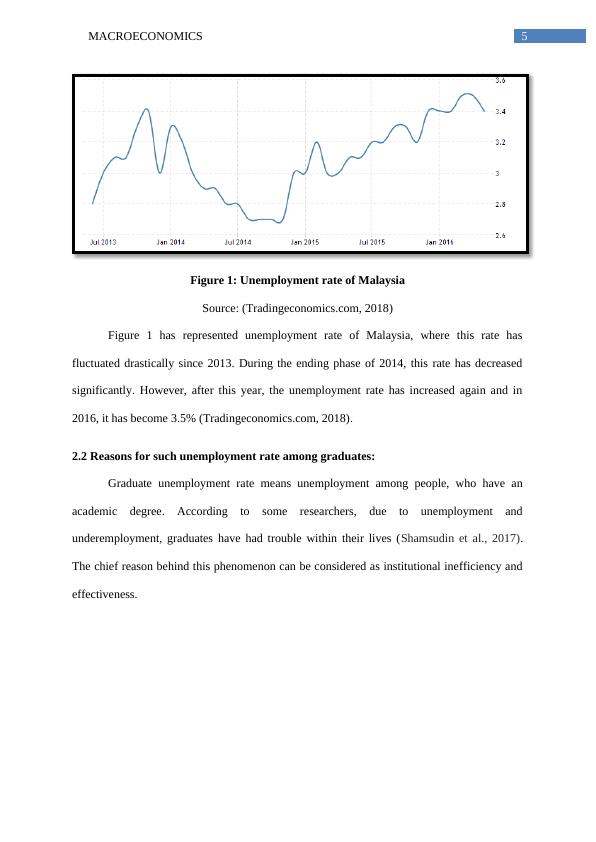Unemployment Rates in Malaysia from 2013-2016: Causes, Effects and Solutions
22 Pages6156 Words240 Views
Added on 2023-06-10
About This Document
This report analyses the unemployment rates in Malaysia from 2013-2016, its causes, effects and solutions. It discusses the reasons for unemployment among graduates, its impact on the society and nation, and provides recommendations to reduce the unemployment rate.
Unemployment Rates in Malaysia from 2013-2016: Causes, Effects and Solutions
Added on 2023-06-10
ShareRelated Documents
Running head: MACROECONOMICS
Macroeconomics
Name of the student
Name of the university
Author Note
Macroeconomics
Name of the student
Name of the university
Author Note

1MACROECONOMICS
Table of Contents
1.0 Introduction:.........................................................................................................................2
1.1 Background of Malaysian Economy:...............................................................................2
1.2 Definition of Unemployment:..........................................................................................2
2.0 Unemployment rates in Malaysia from 2013-2016:............................................................3
2.1 Unemployment rates in Malaysia:...................................................................................3
2.2 Reasons for such unemployment rate among graduates:.................................................5
2.3 Effects of unemployment upon the society and nation:...................................................7
2.4 Solutions to unemployment in Malaysia:.......................................................................12
3.0 Conclusion:........................................................................................................................15
3.1 Effectiveness of policies to reduce the unemployment rate:..........................................15
3.2 Recommendation:..........................................................................................................16
References:...............................................................................................................................18
Table of Contents
1.0 Introduction:.........................................................................................................................2
1.1 Background of Malaysian Economy:...............................................................................2
1.2 Definition of Unemployment:..........................................................................................2
2.0 Unemployment rates in Malaysia from 2013-2016:............................................................3
2.1 Unemployment rates in Malaysia:...................................................................................3
2.2 Reasons for such unemployment rate among graduates:.................................................5
2.3 Effects of unemployment upon the society and nation:...................................................7
2.4 Solutions to unemployment in Malaysia:.......................................................................12
3.0 Conclusion:........................................................................................................................15
3.1 Effectiveness of policies to reduce the unemployment rate:..........................................15
3.2 Recommendation:..........................................................................................................16
References:...............................................................................................................................18

2MACROECONOMICS
1.0 Introduction:
1.1 Background of Malaysian Economy:
Malaysian economy is the fourth largest one in Southeast Asia. Labour productivity
of this country is high compare to that of Indonesia, Vietnam and Philippines. This is because
the country has possessed knowledge-oriented industries by large number. Moreover,
Malaysia has adopted innovative technology for the digital and manufacturing economy.
Thus, this Asian country has a recently developed industrialised market (Nordin & Nordin,
2016). In the beginning of 1970s, Malaysia has had trouble though later the country has
developed its economic condition. During this decade, Malaysia has tried to be like the four
other large economies of Asia, which are, Taiwan, South Korea, Singapore and Hong Kong
and they are called Asian Tiger economies. For this, Malaysia has transited from mining and
agricultural economy to the manufacturing economy. However, Malaysian economy has
started to grow since the 1980s with the help of industrial sector (Rasiah, 2017). In this
context, higher amount of investment has taken a significant part, for instance, heavy
industries have developed as Japanese investors have invested huge amount money in this
sector. Moreover, exports of this country have become the chief reason to grow Malaysia
further. As a result, Malaysia has grown consistently through achieving more than 7% GDP
growth rate and has experienced lower inflation during 1980s and 1990s, respectively
(Tradingeconomics.com, 2018).
1.2 Definition of Unemployment:
Unemployment can be considered as an important issue that can create obstacles for
any developing country to develop its economic condition further (Amiri, Shahriyari,
Shahriyari & Farzin, 2018). Due to insufficient employment opportunity, unemployment can
be seen in those countries though for Malaysia, this condition is better compare to others.
From macroeconomic perspective, both developed and developing countries intend to
1.0 Introduction:
1.1 Background of Malaysian Economy:
Malaysian economy is the fourth largest one in Southeast Asia. Labour productivity
of this country is high compare to that of Indonesia, Vietnam and Philippines. This is because
the country has possessed knowledge-oriented industries by large number. Moreover,
Malaysia has adopted innovative technology for the digital and manufacturing economy.
Thus, this Asian country has a recently developed industrialised market (Nordin & Nordin,
2016). In the beginning of 1970s, Malaysia has had trouble though later the country has
developed its economic condition. During this decade, Malaysia has tried to be like the four
other large economies of Asia, which are, Taiwan, South Korea, Singapore and Hong Kong
and they are called Asian Tiger economies. For this, Malaysia has transited from mining and
agricultural economy to the manufacturing economy. However, Malaysian economy has
started to grow since the 1980s with the help of industrial sector (Rasiah, 2017). In this
context, higher amount of investment has taken a significant part, for instance, heavy
industries have developed as Japanese investors have invested huge amount money in this
sector. Moreover, exports of this country have become the chief reason to grow Malaysia
further. As a result, Malaysia has grown consistently through achieving more than 7% GDP
growth rate and has experienced lower inflation during 1980s and 1990s, respectively
(Tradingeconomics.com, 2018).
1.2 Definition of Unemployment:
Unemployment can be considered as an important issue that can create obstacles for
any developing country to develop its economic condition further (Amiri, Shahriyari,
Shahriyari & Farzin, 2018). Due to insufficient employment opportunity, unemployment can
be seen in those countries though for Malaysia, this condition is better compare to others.
From macroeconomic perspective, both developed and developing countries intend to

3MACROECONOMICS
achieve a goal to maximising their output, respectively. However, Malaysia including other
developing countries presently has experienced unemployment among graduates. According
to Okun’s law, potential GDP can be reduced by 2% if unemployment rate in each economy
reduces by 1% (Ball, Jalles & Loungani, 2015). Unemployment rate can be seen in both short
run and long run. During short term, unemployment occurs due to natural processes when one
graduate moves from one job to other or moves from school to job. New graduates enter into
the workforce but remain unable to search a job and this is the main reason of long-term
unemployment. Hence, the term “unemployment rate” measures the percentage of a country’s
total workforce, who is looking for a job and that can be represented as follows:
Unemployment rate= (Number of persons unemployed/ total number of labour force)* 100
After this global financial crisis (GFC), recession has negatively affected the global
youth population. In 2013, this youth unemployment rate has reached at a historic peak of
13.2% and has remained at 13.1% in 2016. As a result, this global youth unemployment rate
has become three times higher compare to the unemployment rate of adults while this rate has
remained more than two times higher compare to the overall global unemployment rate
(Tyrrell, Bond, Dogaru & Manning, 2017). In Malaysia, this rate among fresh graduates has
also increased from 30% to 34% between 2013 and 2016. Moreover, according to the
Department of Statistics Malaysia, national unemployment rate in the labour force has
remained 3.5% among 14 million Malaysians (Lam, Hassan, Sulaiman & Kamarudin, 2018).
This report has intended to focus on unemployment rate of Malaysia among graduate
between 2013 and 2016. To discuss this, the report has used statistical data and diagrams to
analyse this employment in Malaysia and other countries, properly. Moreover, it has
discussed about impacts of this economic phenomenon on economy and society of this
country briefly.
achieve a goal to maximising their output, respectively. However, Malaysia including other
developing countries presently has experienced unemployment among graduates. According
to Okun’s law, potential GDP can be reduced by 2% if unemployment rate in each economy
reduces by 1% (Ball, Jalles & Loungani, 2015). Unemployment rate can be seen in both short
run and long run. During short term, unemployment occurs due to natural processes when one
graduate moves from one job to other or moves from school to job. New graduates enter into
the workforce but remain unable to search a job and this is the main reason of long-term
unemployment. Hence, the term “unemployment rate” measures the percentage of a country’s
total workforce, who is looking for a job and that can be represented as follows:
Unemployment rate= (Number of persons unemployed/ total number of labour force)* 100
After this global financial crisis (GFC), recession has negatively affected the global
youth population. In 2013, this youth unemployment rate has reached at a historic peak of
13.2% and has remained at 13.1% in 2016. As a result, this global youth unemployment rate
has become three times higher compare to the unemployment rate of adults while this rate has
remained more than two times higher compare to the overall global unemployment rate
(Tyrrell, Bond, Dogaru & Manning, 2017). In Malaysia, this rate among fresh graduates has
also increased from 30% to 34% between 2013 and 2016. Moreover, according to the
Department of Statistics Malaysia, national unemployment rate in the labour force has
remained 3.5% among 14 million Malaysians (Lam, Hassan, Sulaiman & Kamarudin, 2018).
This report has intended to focus on unemployment rate of Malaysia among graduate
between 2013 and 2016. To discuss this, the report has used statistical data and diagrams to
analyse this employment in Malaysia and other countries, properly. Moreover, it has
discussed about impacts of this economic phenomenon on economy and society of this
country briefly.

4MACROECONOMICS
2.0 Unemployment rates in Malaysia from 2013-2016:
2.1 Unemployment rates in Malaysia:
In Malaysia, the unemployment rate has measured the number of people, who are
searching for a job actively as a percentage of the total work force. In 1997, due to financial
crisis, the country has reached at a higher unemployment rate of 2.5%. However, after this
crisis, the economy has experienced unemployment rate from 1997 to 2010 though it has
remained below 4% (Tradingeconomics.com, 2018). In 2013, this rate has increased again
and has remained at a higher level though this unemployment rate has fluctuated after this
year. Instead of this, Department of Statistics has stated that Malaysia has achieved full
employment in 2013 with its unemployment rate of 3.1% while other developing countries
cannot achieve this full employment level.
According to the Labour Force Survey Report, working age population in this nation
has been considered between 15 to 64 years (Del Carpio, Özden, Testaverde & Wagner,
2015). This report considers six main indicators, which are, statistics on labour force,
employed and unemployed person, total population outside labour force, labour force
participation rate (LFPR) and unemployment rate. In 2013, total number of labour force has
remained at 13.6 million while in 2016 it has become 14.7 million. Moreover, labour force
participation rate has increased from 67% to 67.7% between 2013 and 2016. Unemployment
rate, on the other hand, has increased from 3.1% to 3.4% during this period though it has
decreased in 2014 (Dosm.gov.my, 2018).
2.0 Unemployment rates in Malaysia from 2013-2016:
2.1 Unemployment rates in Malaysia:
In Malaysia, the unemployment rate has measured the number of people, who are
searching for a job actively as a percentage of the total work force. In 1997, due to financial
crisis, the country has reached at a higher unemployment rate of 2.5%. However, after this
crisis, the economy has experienced unemployment rate from 1997 to 2010 though it has
remained below 4% (Tradingeconomics.com, 2018). In 2013, this rate has increased again
and has remained at a higher level though this unemployment rate has fluctuated after this
year. Instead of this, Department of Statistics has stated that Malaysia has achieved full
employment in 2013 with its unemployment rate of 3.1% while other developing countries
cannot achieve this full employment level.
According to the Labour Force Survey Report, working age population in this nation
has been considered between 15 to 64 years (Del Carpio, Özden, Testaverde & Wagner,
2015). This report considers six main indicators, which are, statistics on labour force,
employed and unemployed person, total population outside labour force, labour force
participation rate (LFPR) and unemployment rate. In 2013, total number of labour force has
remained at 13.6 million while in 2016 it has become 14.7 million. Moreover, labour force
participation rate has increased from 67% to 67.7% between 2013 and 2016. Unemployment
rate, on the other hand, has increased from 3.1% to 3.4% during this period though it has
decreased in 2014 (Dosm.gov.my, 2018).

5MACROECONOMICS
Figure 1: Unemployment rate of Malaysia
Source: (Tradingeconomics.com, 2018)
Figure 1 has represented unemployment rate of Malaysia, where this rate has
fluctuated drastically since 2013. During the ending phase of 2014, this rate has decreased
significantly. However, after this year, the unemployment rate has increased again and in
2016, it has become 3.5% (Tradingeconomics.com, 2018).
2.2 Reasons for such unemployment rate among graduates:
Graduate unemployment rate means unemployment among people, who have an
academic degree. According to some researchers, due to unemployment and
underemployment, graduates have had trouble within their lives (Shamsudin et al., 2017).
The chief reason behind this phenomenon can be considered as institutional inefficiency and
effectiveness.
Figure 1: Unemployment rate of Malaysia
Source: (Tradingeconomics.com, 2018)
Figure 1 has represented unemployment rate of Malaysia, where this rate has
fluctuated drastically since 2013. During the ending phase of 2014, this rate has decreased
significantly. However, after this year, the unemployment rate has increased again and in
2016, it has become 3.5% (Tradingeconomics.com, 2018).
2.2 Reasons for such unemployment rate among graduates:
Graduate unemployment rate means unemployment among people, who have an
academic degree. According to some researchers, due to unemployment and
underemployment, graduates have had trouble within their lives (Shamsudin et al., 2017).
The chief reason behind this phenomenon can be considered as institutional inefficiency and
effectiveness.

End of preview
Want to access all the pages? Upload your documents or become a member.
Related Documents
Economics Assignment | Economy of Malaysialg...
|25
|4443
|58
Macroeconomics in Global Environmentlg...
|10
|1723
|153
(PDF) Economic Growth in Asialg...
|12
|3032
|176
Macroeconomics: Unemployment and Economic Growth in Greecelg...
|15
|6025
|343
Measures to Overcome Unemployment | Jordan Case Studylg...
|10
|2570
|39
Malaysia’s Middle-Income Challengelg...
|15
|3365
|478
